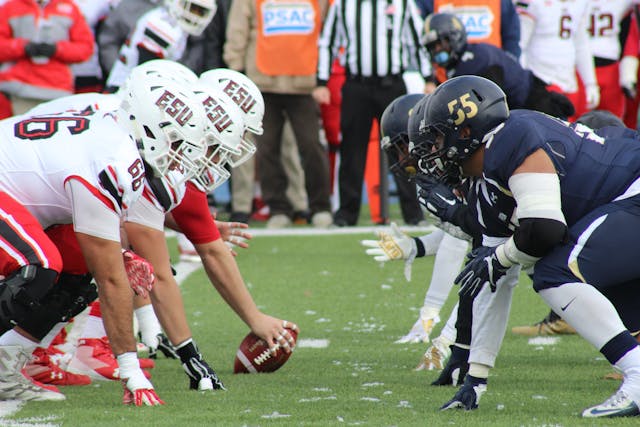Huddle up, team! At GertieBlu, we’re all about celebrating the heartbeat of American culture and its most cherished traditions. Today, we’re tackling a subject that unites millions across the nation—American football. Whether you’re a die-hard fan or just starting to grasp the basics, we’re here to explore why football is more than just a sport in the USA, and we’ll break down the essentials of how the game is played.
The Cultural Significance of American Football
American football isn’t just a game; it’s a cultural phenomenon deeply embedded in the fabric of American life. From the high school fields in small towns to the grand stadiums of the NFL, football serves as a unifying force, bringing people together across all walks of life.
- A National Pastime: Football has surpassed baseball to become the most popular sport in the United States. The Super Bowl, the championship game of the NFL, is not just a sports event; it’s a cultural extravaganza, drawing in over 100 million viewers annually. The day is almost a national holiday, with parties, commercials, and halftime shows that are as anticipated as the game itself.
- Community and Identity: For many communities, especially in smaller towns, the local high school football team is a source of pride and identity. Friday Night Lights, a term coined to describe the excitement of high school football games, highlights the importance of these events as social gatherings that strengthen community bonds.
- Tradition and Ritual: Football is steeped in tradition. From tailgating parties before college games to Thanksgiving Day football, these rituals are passed down through generations. The sport also plays a role in fostering college spirit and loyalty, as alumni across the country support their college teams with fervor.
- A Metaphor for Life: Many see football as a metaphor for life itself—it’s about teamwork, strategy, hard work, and perseverance. The game teaches valuable life lessons about leadership, sacrifice, and resilience, making it more than just a game but a formative experience for many young Americans.

The Basics of How to Play American Football
Now that we’ve touched on why football is such a big deal in American culture, let’s break down the basics of how to play the game. If you’re new to football, don’t worry—once you understand the fundamentals, the game becomes a lot more exciting to watch and even play.
The Objective
The primary objective in football is to score more points than the opposing team by the end of the game. Points can be scored in several ways, but the main goal is to advance the football into the opponent’s end zone.
The Field and Teams
- The Field: A football field is 100 yards long and 53.3 yards wide, with two end zones at either end, each 10 yards deep. The field is marked with yard lines every 5 yards, helping players and fans track the progress of the game.
- Teams: Each team has 11 players on the field at a time, with specialized roles. Teams are divided into offense, defense, and special teams. The offense is responsible for scoring points, the defense works to prevent the opposing team from scoring, and special teams handle kicking plays.
Basic Rules of Play
- The Game Structure: A football game is divided into four quarters, each lasting 15 minutes, with a halftime break after the second quarter. If the game is tied at the end of regulation, overtime periods may be played to determine the winner.
- Starting the Game: The game begins with a kickoff, where one team kicks the ball to the other. The receiving team then attempts to advance the ball as far as possible before being tackled.
- Downs and Yardage: The offense has four attempts, called downs, to advance the ball at least 10 yards. If they succeed, they earn a new set of downs. If they fail after four downs, the other team takes possession of the ball.
- Scoring:
- Touchdown (6 points): Achieved by carrying the ball into the opponent’s end zone or catching it there.
- Field Goal (3 points): A kick through the opponent’s goalposts.
- Extra Point (1 point): A kick through the goalposts after a touchdown.
- Two-Point Conversion (2 points): An attempt to get the ball into the end zone again after a touchdown instead of kicking an extra point.
- Safety (2 points): Awarded when the defense tackles an offensive player with the ball in the offense’s own end zone.
- Turnovers: The defense can gain possession of the ball by intercepting a pass, recovering a fumble, or stopping the offense on fourth down.
Key Positions
- Quarterback (QB): The leader of the offense, responsible for passing the ball and making quick decisions.
- Running Back (RB): Primarily runs the ball but can also catch passes.
- Wide Receiver (WR): Specializes in catching passes from the QB.
- Offensive Linemen: Block defenders to protect the QB and create pathways for the RB.
- Defensive Linemen and Linebackers: Focus on stopping the run and pressuring the QB.
- Cornerbacks and Safeties: Defend against the pass and prevent big plays.

Conclusion
American football is more than just a sport—it’s a reflection of the nation’s values, a source of pride, and a powerful force for community building. Whether you’re drawn in by the spectacle of the Super Bowl, the camaraderie of a local high school game, or simply the thrill of playing, football offers something for everyone.
So the next time you find yourself watching a game or tossing a football around with friends, remember that you’re participating in a rich cultural tradition that millions cherish. And if you’re new to the game, don’t be intimidated. With a little knowledge and some practice, you’ll be ready to enjoy all that football has to offer.
This blog post was crafted to inspire both seasoned fans and newcomers to appreciate the cultural significance of American football and understand the basics of playing the game.
See you on the field, GertieBlu









